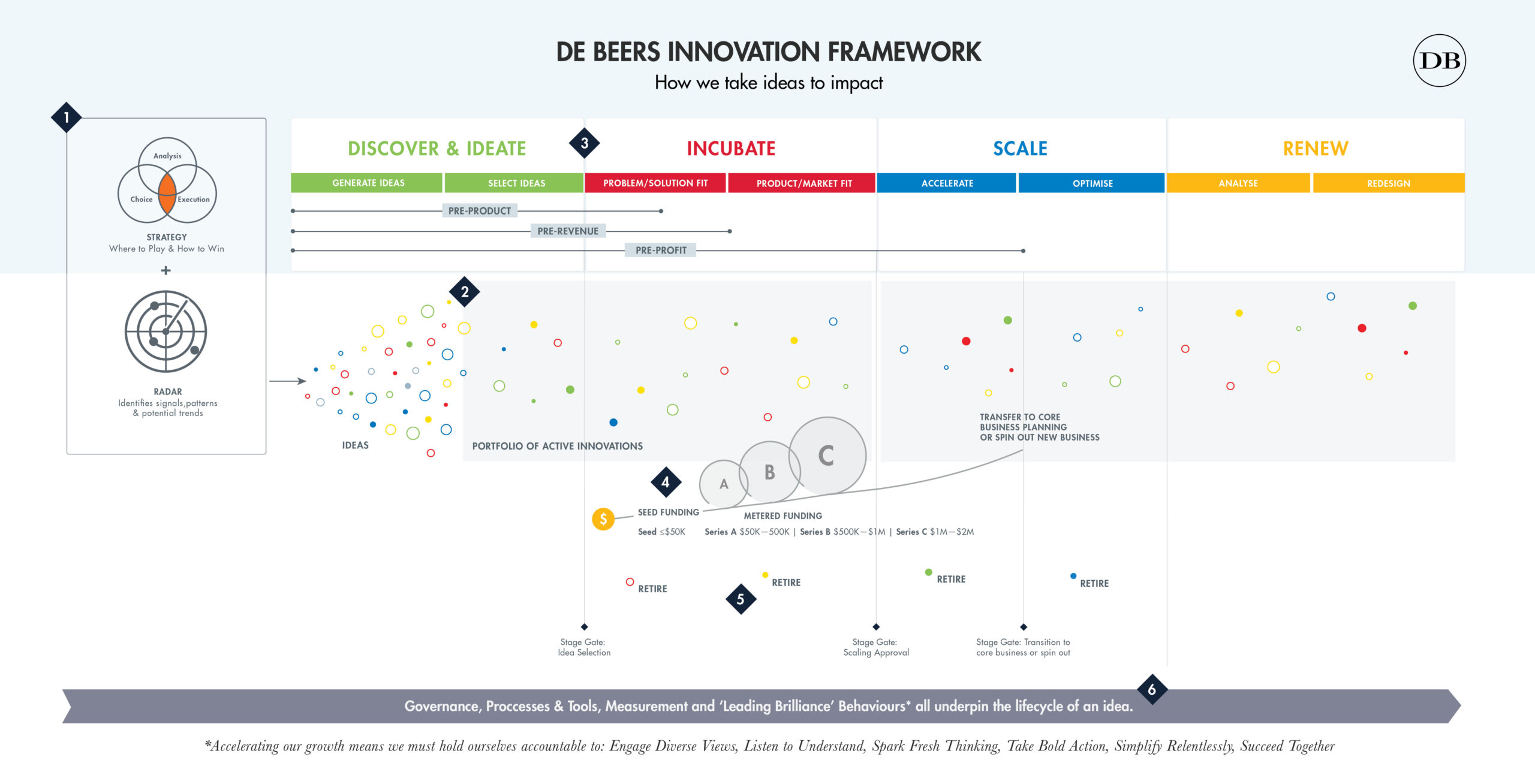Innovation Framework
Ignite™ developed a comprehensive corporate Innovation Framework covering the Strategy Model, Innovation Portfolio and a rigorous process where ideas are shepherded through the DISCOVER & IDEATE — INCUBATE — SCALE — RENEW stages. We consistently measure innovation progress, and have a Governance and Funding process that oversees innovation investment.
1. Corporate Strategy and Sensory Capability
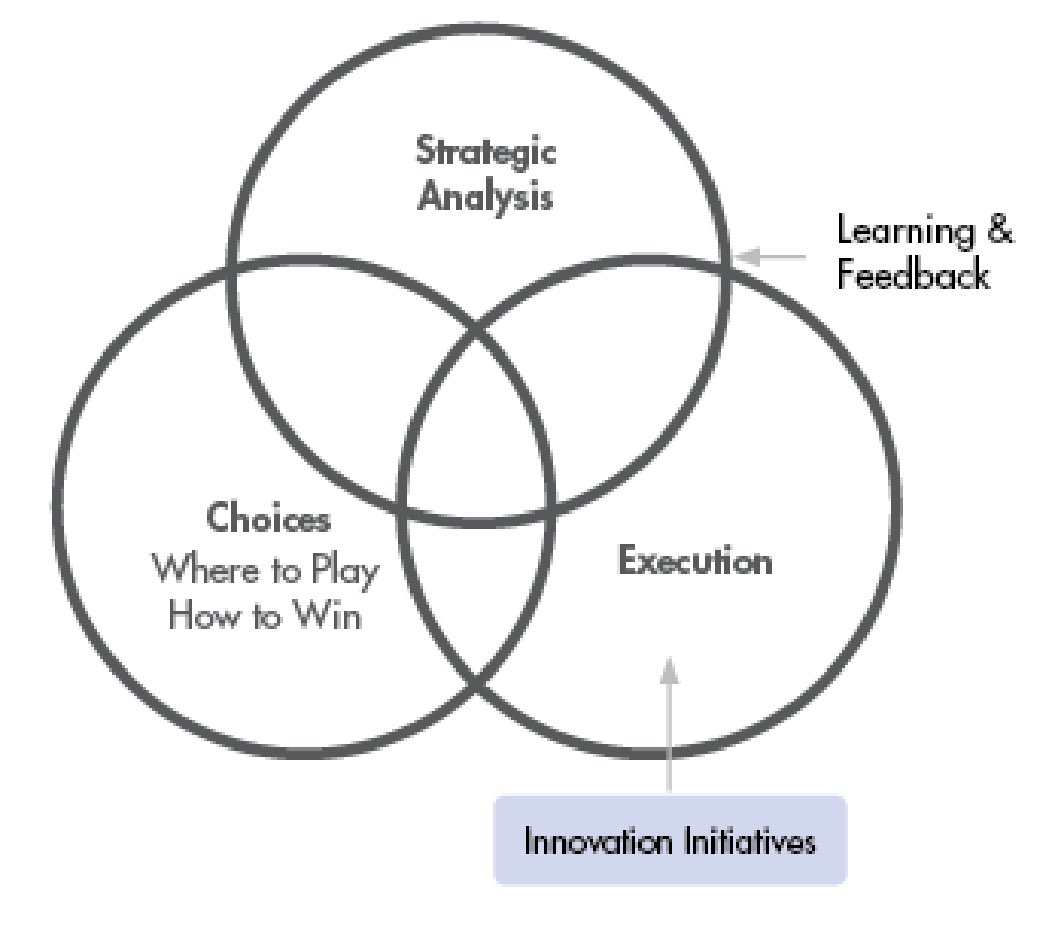
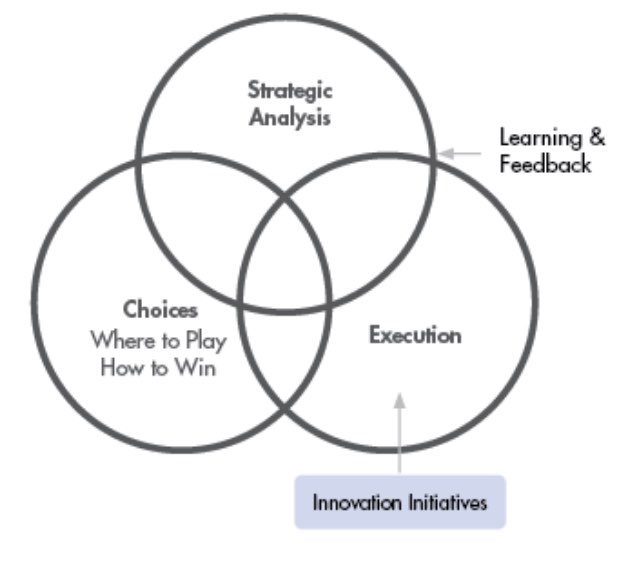
A major portion of our transformation and growth agenda for De Beers Group requires innovation in various forms—taking new process, product and service and new business model ideas to impact.
Strategic Analysis & Choices
Innovation activities need to be informed and guided by our corporate strategy. What we spend money researching, testing and developing need to tie back explicitly to the strategic choices we make as a business.
These choices fall broadly into ‘Where to Play’ choices (which parts of the value chain, geographies, customer segments and so on) and ‘How to Win’ choices (how we think we should go about competing e.g. product mix, pricing, technology choices, make or buy, partnering and so on).
These choices are usually informed by strategic analysis about the industry, competition and changing customer and consumer needs. Our choices are then translated into a prioritised set of initiatives that we implement. We gather data and learning as we implement, that can be used to enrich our analysis and further refine our choices. This creates a virtuous circle.
The role of innovation in this strategy process is highlighted in the graphic above.
Strategy Execution
This focuses on taking the choices we make and translating them into a prioritised portfolio, resource allocation, appropriate structure and execution roadmap. Importantly the portfolio should contain shorter-term improvements to the core business (to fund the journey), medium-term initiatives that will realise the full potential in the ‘Where to Play’ and ‘How to Win’ choices and enabling capability builds (e.g. building a leading digital capability) necessary to fulfil the potential of the strategy and the vision.
In today’s increasingly uncertain environment, it’s imperative that we move forward through rapid testing and learning, adapting all the time. The innovation process underpins a more emergent approach to strategy, and forges an increasingly stronger overlap between the two disciplines.
Sensory Capability: The Innovation Radar
The innovation radar forms the backbone of our sensory capability build, enabling us to track hundreds of emerging trends and technologies across all industries and consider their relevance for De Beers.
The radar helps us to identify connections and start to see patterns forming between signals as they start to emerge. We can look at trends from both an opportunity perspective and also a potential disruptor perspective. This provides a basis for ideation around specific challenges or new opportunities.
2. Innovation Portfolio
Corporate Innovation today demands that we balance both the need to optimise the performance of our existing, profitable core business, whilst simultaneously searching for viable new business models that can form part of our future, profit generating core. This ‘ambidextrous’ approach is a challenging but critical balancing act. Further, we have to retire initiatives we cannot develop a viable pathway to profitability for. Efficient and effective innovation capital allocation is the central portfolio management task.
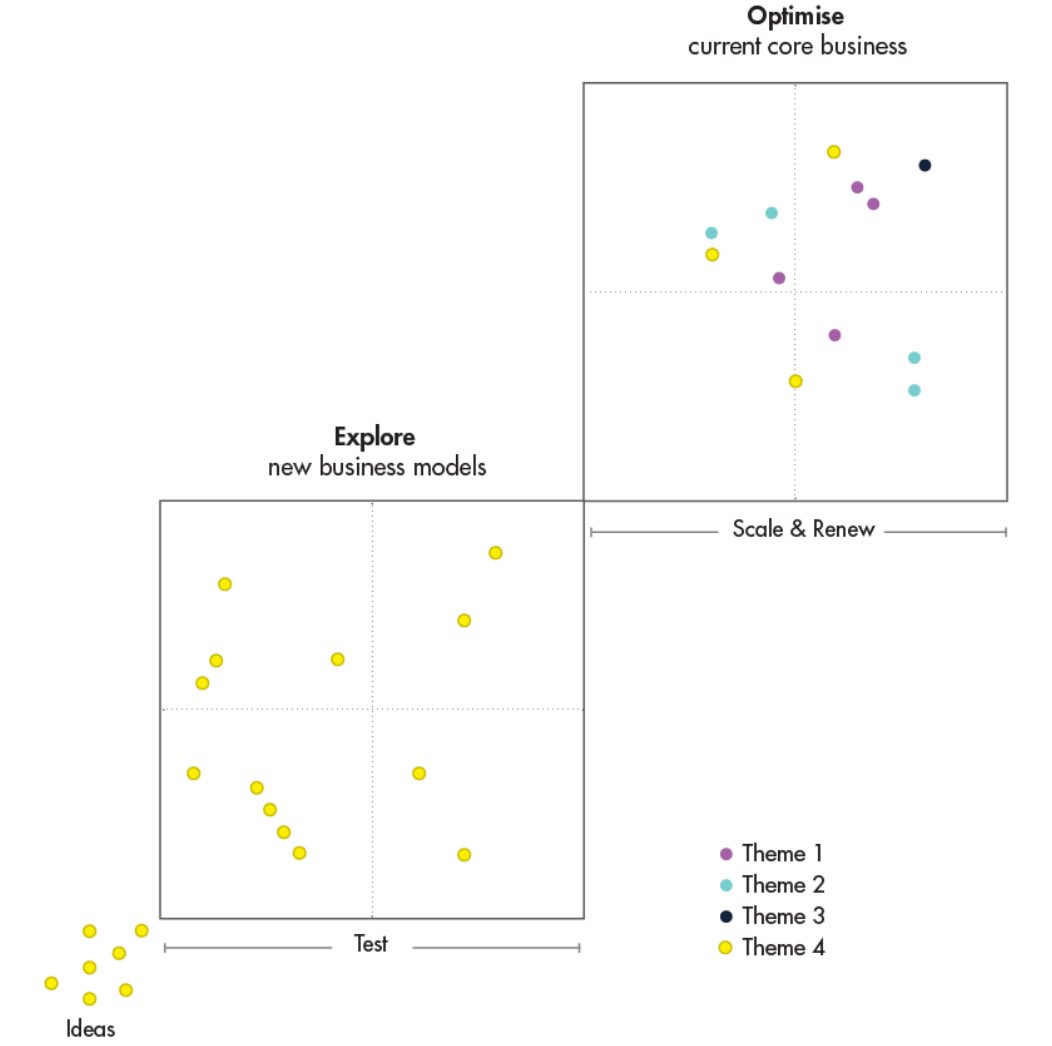
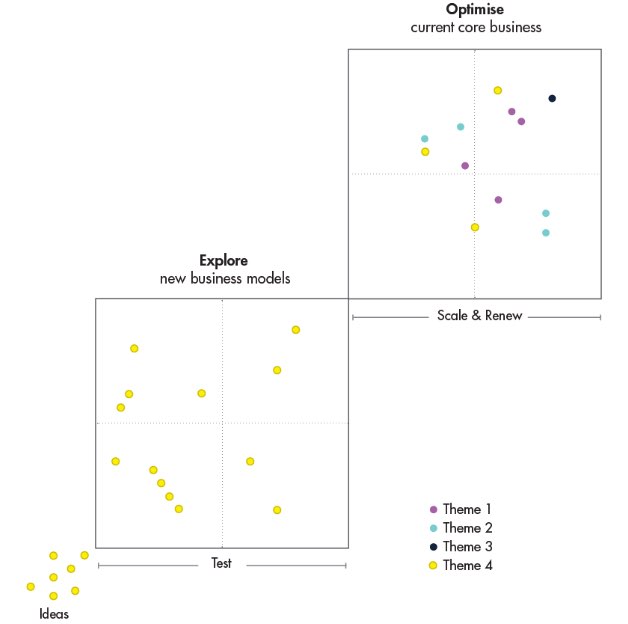
Our overall Innovation Portfolio therefore breaks down into an Optimise sub-portfolio and an Explore sub-portfolio.
The Explore sub-portfolio contains initiatives focused on adjacent innovation or more transformational innovation opportunities. This is where the business models of the future are developed and tested. Current examples include our Lightbox, GemFair and Tracr start-ups.
The Optimise sub-portfolio focuses on innovations that aim to improve a key activity or value proposition element in our current core business. Examples include technologies that can deliver a step change in our recovery or rough diamond sorting activities, or the De Beers Auctions ‘Buy Now’ e-commerce for rough diamond proposition.
Innovation initiatives also tend to cluster into themes that tie back to our strategy or can be shown as different types of innovation e.g. new products or new business models.
Historically, we have put too much money into early stage unproven ideas, constraining our returns on innovation investments. A key aspect of managing our innovation portfolio is ensuring efficient and effective use of capital to ensure constrained innovation investment is directed towards those initiatives generating traction, building rapid revenue growth and demonstrating a pathway to commercial viability, redirecting funding away from other initiatives if necessary.
3. Lifecycle of an idea
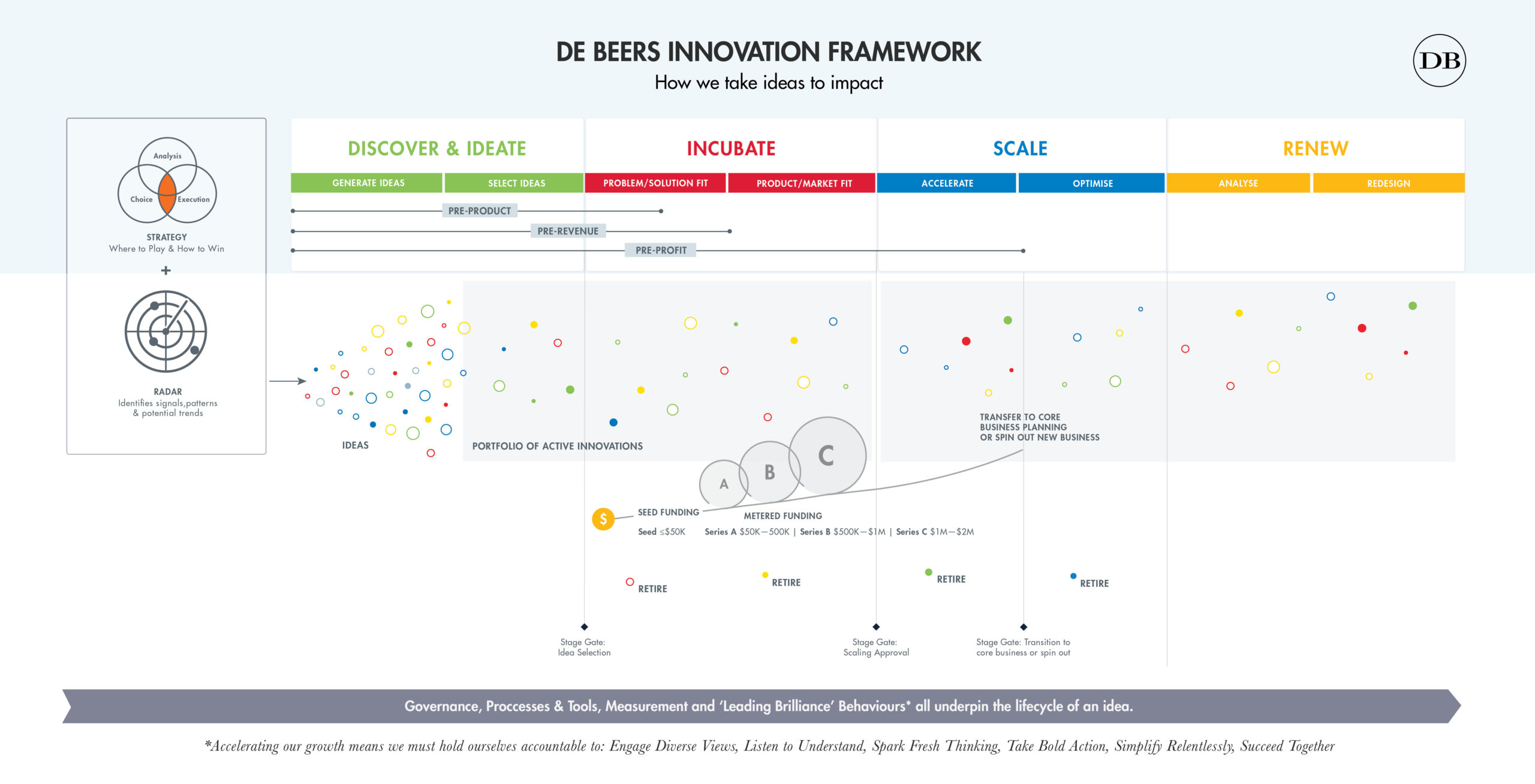
Ideas are shepherded through the following lifecycle stages:
DISCOVER & IDEATE
The Discover & Ideate stage is where we generate new ideas and possible solutions, organically or through formal approaches like ideation challenges or sprints.
INCUBATE
The Incubate stage is where we test our understanding of the problem, whether the solution we have in mind will solve that problem, build traction and evidence that we can profitably take an innovation to scale.
SCALE
Within the Scale stage, it is time to double down on our validated innovations. A step change in investment supports scaling innovations to their full potential.
RENEW
In the Renew stage, you reassess the relevance and potential of mature business models and establish whether they should be retired or revised to adapt to the changing business and market.
4. Governing and Funding Innovation
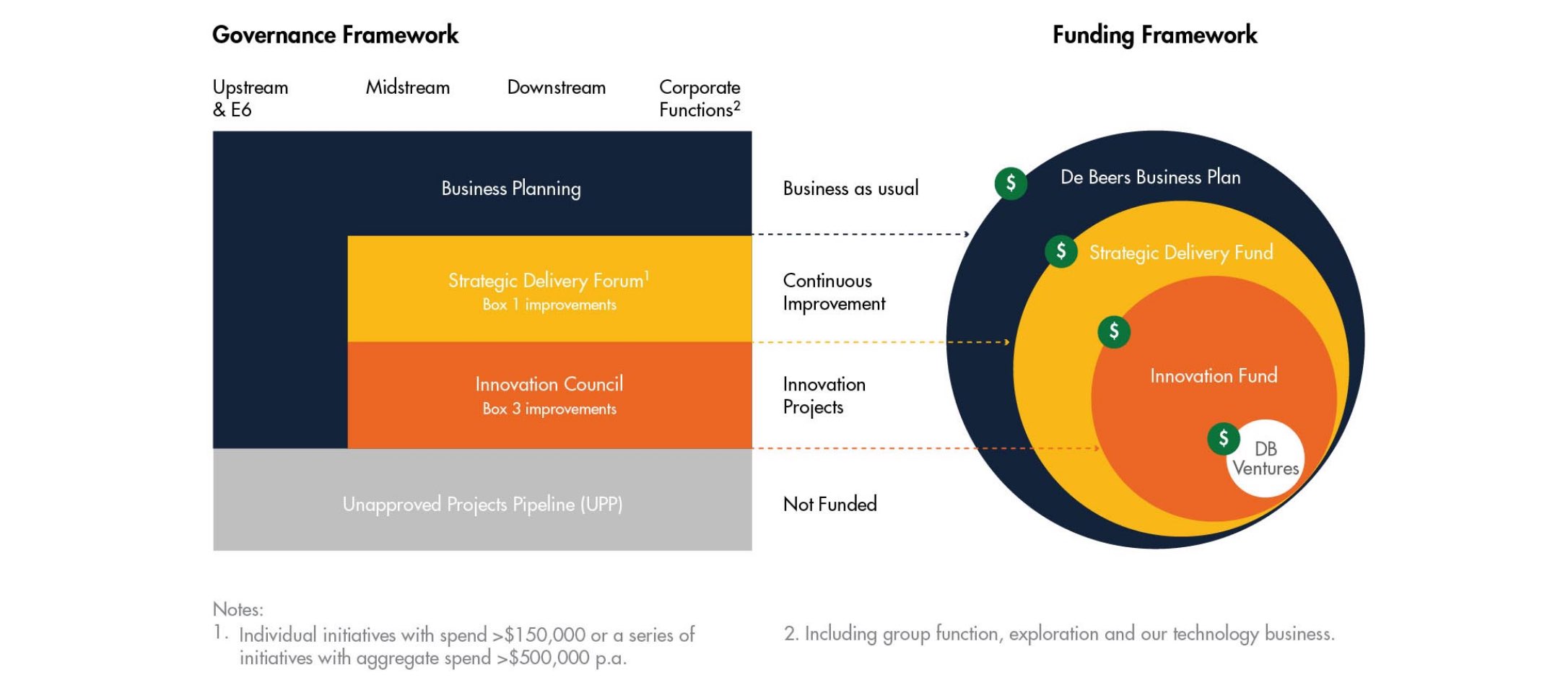
Continuous improvement initiatives in the corporate functions, midstream and downstream businesses are funded from the Strategic Delivery Fund. For innovation projects, a milestone-based approach to funding is followed. As teams achieve certain pre-determined value accretive milestones (such as closure of key knowledge gaps, certain levels of customer sign-ups, revenue and so on), next level funding can be secured from the Innovation Fund, overseen by the Innovation Investment Committee (IIC).
Initial or seed stage funding is provided for pre-product initiatives. The key is to avoid wasteful upfront spending behind unproven ideas and instead, provide teams with just enough money to run the first wave of tests to close out key knowledge gaps or test the most critical assumptions. Innovation teams are a bit like goldfish — feed them too much money and they will explode!
5. Measuring Innovation

Measuring Innovation is a notoriously difficult, yet essential challenge. Taking ideas to impact requires that we look at innovation performance in terms of:
Innovation Activity — Speed and Cost
How quickly can we take ideas to market and how can we spend as little as possible behind unproven ideas? The IGNITE™ methodology is designed for speed, and metered funding helps ensure we minimise wasteful spending.
Innovation Impact — Top line and bottom line growth
Whilst innovation can have a number of impacts (eg. social impact), our primary focus is financial impact. Innovation has to deliver value where value is initially revenues and then profits.
We use a cascade of activity and impact metrics and closely track these at the experiment, initiative and overall innovation portfolio level.
6. Training, Tools and Methodologies

Innovation is really about people and mindset transformation. Our training and change programs focus on the capabilities and mindsets needed tomorrow: customer centricity, lean innovation and continuous transformation. Tailormade to your level of capability, our training focuses on building your understanding of the Innovation Framework and is delivered through a blended approach optimising multiple mediums, including online, virtual and face to face learning opportunities.
Underpinning the Innovation Framework are the tools and methodologies that bring ideas to life. The Ignite team continuously review, test and develop existing and new tools and methodologies, ensuring the best fit innovation approach. The Innovation Playbook gives a comprehensive guide of these tools and methodologies and how they can be applied by innovation teams within the De Beers Group. This is an area of constant evolution so new training, tools and methodologies will be published periodically as they are developed and tested. This will ensure that we continue to develop our innovation capabilities across the business and stay abreast of corporate innovation leading practices.
